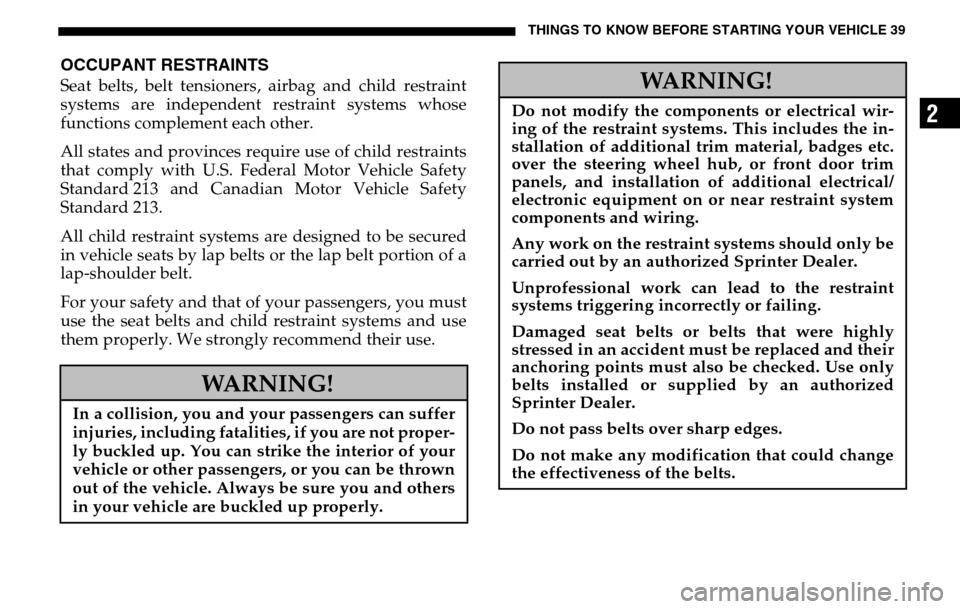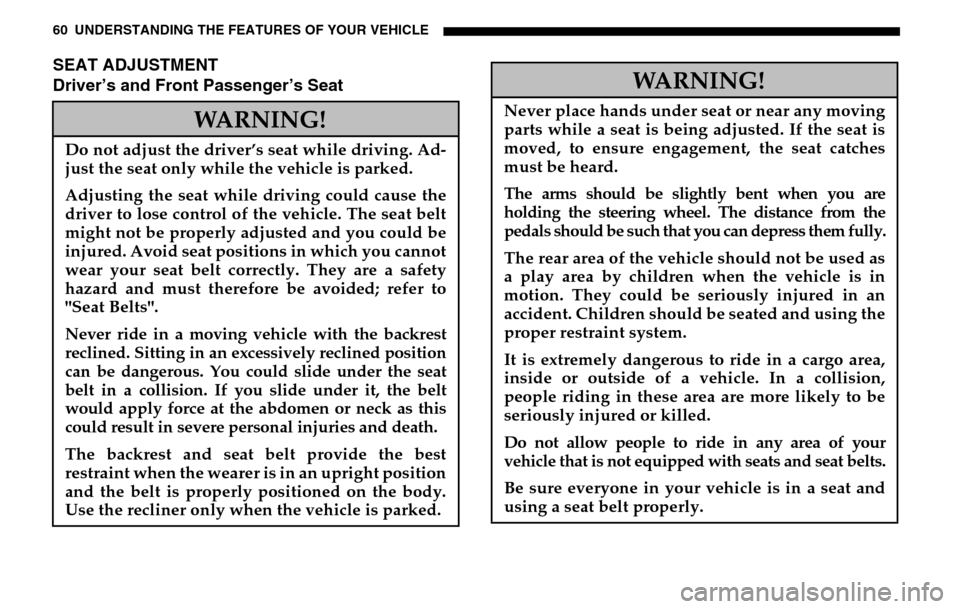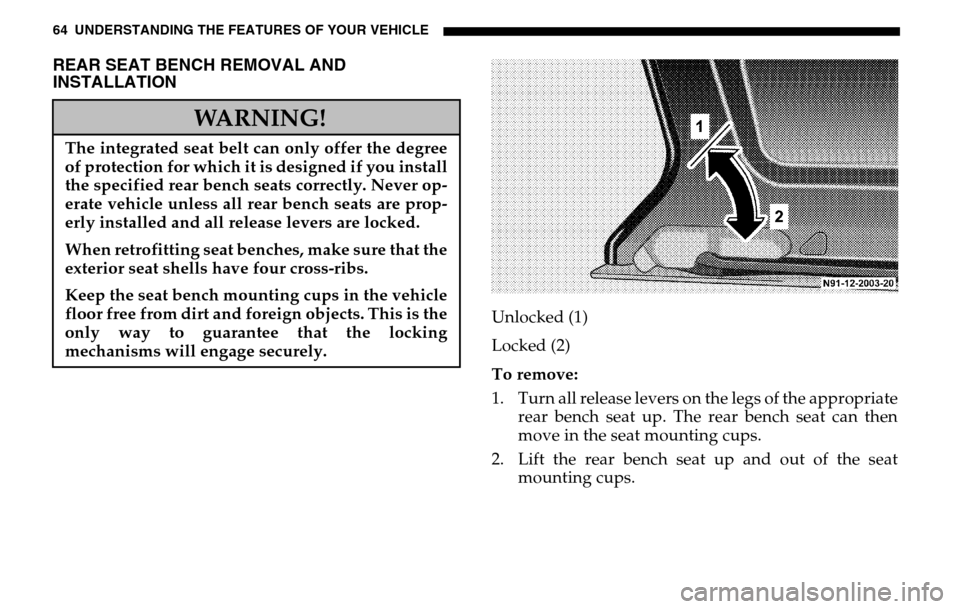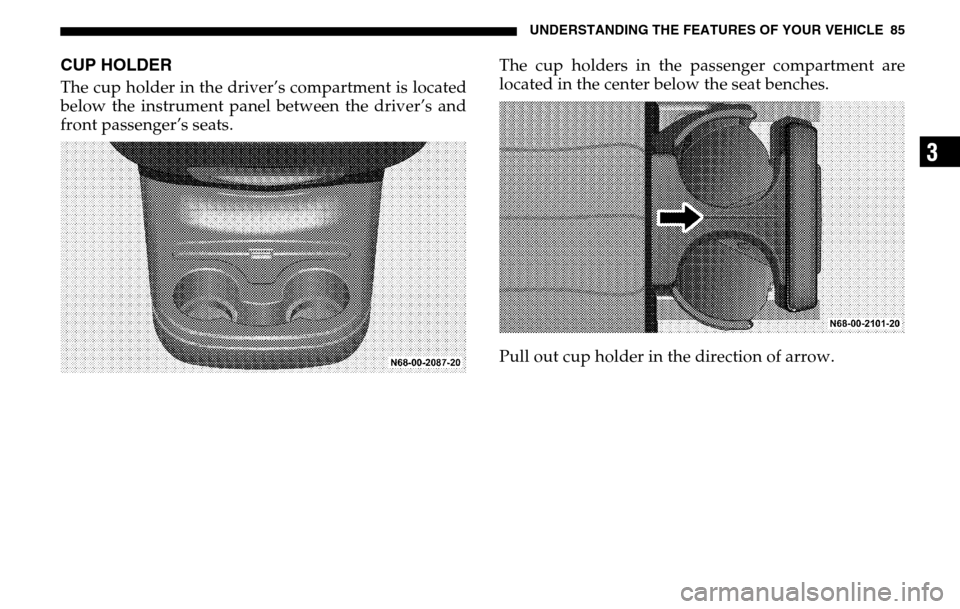2005 DODGE SPRINTER seats
[x] Cancel search: seatsPage 39 of 288

THINGS TO KNOW BEFORE STARTING YOUR VEHICLE 39
2
OCCUPANT RESTRAINTSSeat belts, belt tensioners, airbag and child restraint
systems are independent restraint systems whose
functions complement each other.
All states and provinces require use of child restraints
that comply with U.S. Federal Motor Vehicle Safety
Standard 213 and Canadian Motor Vehicle Safety
Standard 213.
All child restraint systems are designed to be secured
in vehicle seats by lap belts or the lap belt portion of a
lap-shoulder belt.
For your safety and that of your passengers, you must
use the seat belts and child restraint systems and use
them properly. We strongly recommend their use.
WARNING!
In a collision, you and your passengers can suffer
injuries, including fatalities, if you are not proper-
ly buckled up. You can strike the interior of your
vehicle or other passengers, or you can be thrown
out of the vehicle. Always be sure you and others
in your vehicle are buckled up properly.
WARNING!
Do not modify the components or electrical wir-
ing of the restraint systems. This includes the in-
stallation of additional trim material, badges etc.
over the steering wheel hub, or front door trim
panels, and installation of additional electrical/
electronic equipment on or near restraint system
components and wiring.
Any work on the restraint systems should only be
carried out by an authorized Sprinter Dealer.
Unprofessional work can lead to the restraint
systems triggering incorrectly or failing.
Damaged seat belts or belts that were highly
stressed in an accident must be replaced and their
anchoring points must also be checked. Use only
belts installed or supplied by an authorized
Sprinter Dealer.
Do not pass belts over sharp edges.
Do not make any modification that could change
the effectiveness of the belts.
Page 49 of 288

THINGS TO KNOW BEFORE STARTING YOUR VEHICLE 49
2
AIRBAG AND BELT TENSIONERSThe vehicle is equipped with an airbag for the driver
and the front seat passenger as well as belt tensioners
for the driver and the front passenger. The system is
known as a Supplemental Restraint System (SRS). It
has been designed to work together with the seat belt
and to supplement.SRS Malfunction Indicator LampWhen the key is in position 2 in the ignition lock, the
malfunction indicator lamp 1 will light up in the
instrument cluster for about 4 seconds as a function
check.
Belt TensionersThe belt tensioners are located on the three-point seat
belts of the driver’s and front passenger seats.
The belt tensioners will not operate unless the key has
been turned to position 1 or 2 in the ignition lock.
The airbag and / or belt tensioners are designed to only
trigger in certain frontal impacts as not all accidents
call for airbag and / or belt tensioner deployment.
WARNING!
Do not put anything on or around the front airbag
covers or attempt to manually open them. You
may damage the airbags and you could be injured
because the airbags are not there to protect you.
These protective covers for the airbag cushions are
designed to open only when the airbags are inflat-
ing.
WARNING!
If the malfunction indicator lamp 1 does not
light up when the key is in position 2 in the igni-
tion lock, if it flickers or lights up while the vehi-
cle is moving, there might be a problem in the
airbag system. There is then a danger that the air-
bag will not deploy in the event of an accident or
will deploy when it should not do so. Have the ve-
hicle inspected and repaired by an authorized
Sprinter Dealer without delay.
Page 60 of 288

60 UNDERSTANDING THE FEATURES OF YOUR VEHICLESEAT ADJUSTMENT
Driver’s and Front Passenger’s Seat
WARNING!
Do not adjust the driver’s seat while driving. Ad-
just the seat only while the vehicle is parked.
Adjusting the seat while driving could cause the
driver to lose control of the vehicle. The seat belt
might not be properly adjusted and you could be
injured. Avoid seat positions in which you cannot
wear your seat belt correctly. They are a safety
hazard and must therefore be avoided; refer to
"Seat Belts".Never ride in a moving vehicle with the backrest
reclined. Sitting in an excessively reclined position
can be dangerous. You could slide under the seat
belt in a collision. If you slide under it, the belt
would apply force at the abdomen or neck as this
could result in severe personal injuries and death.The backrest and seat belt provide the best
restraint when the wearer is in an upright position
and the belt is properly positioned on the body.
Use the recliner only when the vehicle is parked.
WARNING!
Never place hands under seat or near any moving
parts while a seat is being adjusted. If the seat is
moved, to ensure engagement, the seat catches
must be heard.The arms should be slightly bent when you are
holding the steering wheel. The distance from the
pedals should be such that you can depress them fully.The rear area of the vehicle should not be used as
a play area by children when the vehicle is in
motion. They could be seriously injured in an
accident. Children should be seated and using the
proper restraint system.
It is extremely dangerous to ride in a cargo area,
inside or outside of a vehicle. In a collision,
people riding in these area are more likely to be
seriously injured or killed.Do not allow people to ride in any area of your
vehicle that is not equipped with seats and seat belts.Be sure everyone in your vehicle is in a seat and
using a seat belt properly.
Page 64 of 288

64 UNDERSTANDING THE FEATURES OF YOUR VEHICLEREAR SEAT BENCH REMOVAL AND
INSTALLATION
Unlocked (1)
Locked (2)
To remove:
1. Turn all release levers on the legs of the appropriate rear bench seat up. The rear bench seat can then
move in the seat mounting cups.
2. Lift the rear bench seat up and out of the seat mounting cups.
WARNING!
The integrated seat belt can only offer the degree
of protection for which it is designed if you install
the specified rear bench seats correctly. Never op-
erate vehicle unless all rear bench seats are prop-
erly installed and all release levers are locked.
When retrofitting seat benches, make sure that the
exterior seat shells have four cross-ribs.
Keep the seat bench mounting cups in the vehicle
floor free from dirt and foreign objects. This is the
only way to guarantee that the locking
mechanisms will engage securely.
Page 65 of 288

UNDERSTANDING THE FEATURES OF YOUR VEHICLE 65
3
To install:
1. With the rear bench seat facing in the direction of travel, insert the legs of the rear bench seat in the
respective seat mounting cups on the floor.
2. Slide the rear bench seat forwards with some force as far as it will go, until the release levers are heard
to engage and all release levers are parallel to the
vehicle floor.
Retrofitting Seat Mounting Cups
WARNING!
Additional rear bench seats can be added if seat
mounting cups are properly installed.
For reasons of safety, only have seat mounting
cups retrofitted by an authorized Sprinter Dealer.
Never exceed the maximum permissible number
of rear bench seats for the specific vehicle.
For more information contact your authorized
Sprinter Dealer.
Page 85 of 288

UNDERSTANDING THE FEATURES OF YOUR VEHICLE 85
3
CUP HOLDERThe cup holder in the driver’s compartment is located
below the instrument panel between the driver’s and
front passenger’s seats. The cup holders in the passenger compartment are
located in the center below the seat benches.
Pull out cup holder in the direction of arrow.
Page 154 of 288

154 STARTING AND OPERATING
The handling characteristics of a vehicle when laden
are dependent on the type of load and the distribution
of the load within the vehicle.
Carrying heavy or bulky loads may alter the vehicle’s
handling characteristic.Loading GuidelinesPlease note and comply with the following information
when loading and transporting goods.
Do not allow the load, including passengers, to exceed the permitted gross vehicle weight or the
permitted axle loads for the vehicle. Bear in mind
that the unladen weight could be increased by
installing items of optional equipment and
accessories.
Distribute the load uniformly. Excessive loads on individual points of the load surface could cause
damage to the floor covering.
Transport heavy loads between the axles near the rear axle as low as possible in the vehicle.
Secure any kind of load with sufficient wear and tear-resistant load restraints. See tie-down rings.
WARNING!
Unsecured or poorly secured loads, and seats that
have been removed, could move around the vehi-
cle interior uncontrollably in the event of sudden
braking, a rapid change in direction or an acci-
dent. This increases the risk of injury to occu-
pants in these situations.
Secure and position a load as described in the
following loading guidelines.
Piling up heavy objects or placing them on upper
shelves or loading them otherwise high up in the
vehicle will significantly raise the center of
gravity of the vehicle. Placing excessive loads on
individual points of the load surface or behind
the rear axle will also adversely affect the
handling characteristics of your vehicle and may
lead to loss of control over the vehicle.
Road safety and tire durability are adversely
affected if the permissible axle loads or gross
vehicle weight are exceeded due to the vehicle’s
load. Braking and stopping distances can be
significantly longer.
Page 155 of 288

STARTING AND OPERATING 155
5
Protect sharp edges with padding.
Check the tire pressures after loading the vehicle.
For passenger vans:
Do not stack loads higher than the upper edge of the backrests.
Always place the load against the backrests of the seat benches.
Whenever possible, transport loads behind seats that are not occupied.
Distribute the load in such a way that the permissible axle loads are not exceeded when the
vehicle is equipped with the maximum number of
seats. Loading the luggage compartment up to the
maximum payload would cause the permissible
rear axle load to be exceeded.
BRAKES
Service Brake
WARNING!
When the engine is not running, the brake and
steering systems are without power assistance.
Under these circumstances, a much greater effort
is necessary to stop or steer the vehicle.
After driving in heavy rain for some time without
applying the brakes or through water deep
enough to wet brake components, the first
braking action may be somewhat reduced and
increased pedal pressure may be necessary. Be
sure to maintain a safe distance from vehicles in
front.
Resting your foot on the brake pedal will cause
excessive and premature wear of the brake pads.
It can also result in the brakes overheating,
thereby significantly reducing their effectiveness.
It may not be possible to stop the vehicle in
sufficient time to avoid an accident.